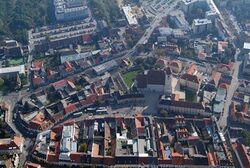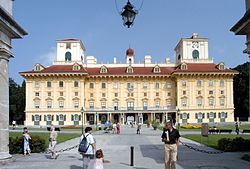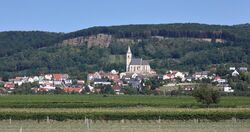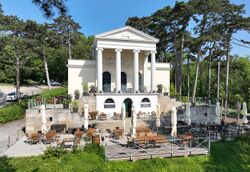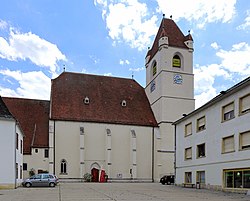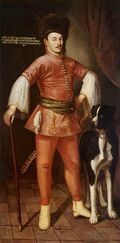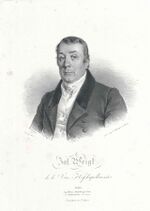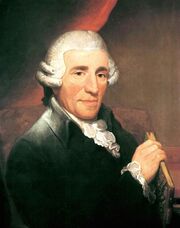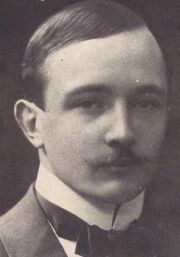Eisenstadt
Topic: Place
 From HandWiki - Reading time: 7 min
From HandWiki - Reading time: 7 min
Eisenstadt | |
|---|---|
City | |
|
Clockwise from top: aerial view of the city, state government building, Schloss Esterházy, calvary with Bergkirche | |
| Coordinates: [ ⚑ ] : 47°51′N 16°31′E / 47.85°N 16.517°E | |
| Country | |
| State | Burgenland |
| District | Statutory city |
| Government | |
| • Mayor | Thomas Steiner (ÖVP) |
| Area | |
| • Total | Template:Austria population Wikidata km2 (Formatting error: invalid input when rounding sq mi) |
| Elevation | 182 m (597 ft) |
| Population | |
| • Total | Template:Austria population Wikidata |
| Time zone | UTC+1 (CET) |
| • Summer (DST) | UTC+2 (CEST) |
| Postal code | 7000 |
| Area code | 02682 |
| Vehicle registration | E |
| Budget | €42.256 million (2021)[1] |
| Expenditure | €42.255 million (2021)[2] |
| Website | www.eisenstadt.gv.at |
Eisenstadt (German pronunciation: [ˈaɪzn̩ʃtat] (![]() listen); Template:Lang-bar; Hungarian: Kismarton; Croatian: Željezni grad or Željezno; Slovene: Železno) is the capital city of the Austrian state of Burgenland. With a population of 15,074 (as of 2023), it is the smallest state capital and the 38th-largest city in Austria overall. It lies at the foot of the Leitha Mountains hill range.
listen); Template:Lang-bar; Hungarian: Kismarton; Croatian: Željezni grad or Željezno; Slovene: Železno) is the capital city of the Austrian state of Burgenland. With a population of 15,074 (as of 2023), it is the smallest state capital and the 38th-largest city in Austria overall. It lies at the foot of the Leitha Mountains hill range.
From 1648 to 1921, Kismarton/Eisenstadt was part of the Habsburg Empire's Kingdom of Hungary and the seat of the Hungarian noble family Eszterházy. During this time, the composer Joseph Haydn lived and worked in Eisenstadt as a court musician under the patronage of the Esterházy family. After the cessation of Burgenland to Austria in 1921, the city became the province's capital in 1925. As the state capital of Burgenland, it functions as a center of public administration and services[3][4] and is the seat of three institutes of higher education.
Geography
Eisenstadt lies on a plain leading down to the river Wulka, at the southern foot of the Leitha Mountains, about 12 kilometres (7 miles) from the Hungarian border.
Subdivisions
Eisenstadt is divided into three districts (Ortsteile):
- Eisenstadt-Stadt (Eisenstadt proper)
- Kleinhöflein im Burgenland (Hungarian: Kishöflány; Croatian: Mala Holovajna) – a town that lies to the west of Eisenstadt proper
- St. Georgen am Leithagebirge (Lajtaszentgyörgy; Svetojurje) – a town that lies to the east of Eisenstadt proper
Furthermore, Eisenstadt is divided into five Katastralgemeinden:
- Eisenstadt-Stadt
- Oberberg, or Oberberg-Eisenstadt (Hungarian: Felsőkismartonhegy; Croatian: Željezno Brig) – the northern area of Eisenstadt starting beyond the Jewish quarter
- Unterberg, or Unterberg-Eisenstadt (Alsókismartonhegy; Željezno Donji Brig) – the southern area of Eisenstadt starting beyond the Kalvarienbergplatz & the Ruster Straße and including the Jewish quarter
- Kleinhöflein im Burgenland
- St. Georgen am Leithagebirge
Other informal areas of the city include Wiesäcker and Lobäcker, which lie south of the Eisbach, a tributary of the Wulka. The city is surrounded by the district (Bezirk) of Eisenstadt-Umgebung.
The city previously included the districts (Ortsteile) of Eisenstadt-Stadt, Eisenstadt-Oberberg, Eisenstadt-Unterberg, and Eisenstadt-Schloßgrund (Kismartonváralja).
Nearby municipalities
- Großhöflein, Müllendorf, Steinbrunn, Neufeld/Leitha and Ebenfurth
- Hornstein
- Wulkaprodersdorf, Trausdorf/Wulka (on the Wulka and Eisbach)
Climate
Script error: No such module "weather box". Script error: No such module "weather box".
Names and etymology
The city's name means "Iron City" and was first recorded in 1118 as Castrum ferrum, referring to the history of iron mining and iron trade in the area. The first written mention of the town is from 1264 as "minor Mortin", matching the Hungarian name, Kismarton, which recalls Martin of Tours, the patron saint of the main church.
History
Archeological finds prove that the Eisenstadt area was already settled in the Hallstatt period. Celts and Romans settled somewhat later. During the Migration Period, the area was settled by different Germanic tribes and the Huns. Around 800, during the reign of Charlemagne, settlement by the Bavarii began. The territory became part of the Kingdom of Hungary in the 11th century.
The fortress built on the original earth works was destroyed by the troops of Margrave Leopold III of Austria. In 1241, it was destroyed by the Mongol invaders. In 1373, the town came into the possession of the Kanizsai family, who rebuilt the walls surrounding the town and built a fortress at the site of the present day castle between 1388 and 1392. In 1388, Eisenstadt was given the right to hold markets by Emperor Sigismund.
From 1440 Archduke Albert VI of Austria held the town as collateral for a loan. In 1451, Matthias Corvinus ceded it to Frederick III, Holy Roman Emperor in return for the Holy Crown of Hungary. Matthias Corvinus reconquered it by force in 1482, but Maximilian I acquired it again in 1490. It remained under Habsburg rule until 1622; however, the Ottoman Empire briefly conquered Kismarton in 1529 and 1532 during their advances on the city of Vienna (see Ottoman wars in Europe). It was destroyed by fire in 1589.
In 1648, it passed under the rule of the Esterházy family. These Hungarian princes permanently changed the face of the city due to their extensive construction, especially on their castle, Schloss Esterházy. During this period, the city was captured by the army of Imre Thököly in 1683, and it saw the defeat of the rebel kuruc army of Sándor Károlyi by the Habsburgs in 1704. It was again destroyed by fire in 1776.
The appointment of Joseph Haydn as the prince's Hofkapellmeister (court orchestra director, composing and performing music) began the great artistic period in the city's history. In 1809, Eisenstadt was occupied by France troops during the Napoleonic Wars; in 1897, it was joined to the railway network.
Until the end of World War I, it was the seat of Kismarton district in Sopron county in the Kingdom of Hungary. Without plebiscite, the city and the entire Hungarian territory of Burgenland (with the exception of the city of Sopron and 11 other villages in which referendums were held) was annexed to Austria by the Saint-Germain and Treaties of Trianon in 1921. Since 30 April 1925, Eisenstadt has been the seat of the Burgenland state government and thus the state capital. During World War II, Eisenstadt was heavily bombarded. On 2 April 1945, it was captured by Soviet troops of the 3rd Ukrainian Front in the course of the Vienna Offensive, and the city remained under Soviet occupation until 1955. In 1960, it became the see of the Roman Catholic Diocese of Eisenstadt.
Politics
The current mayor of Eisenstadt is Thomas Steiner (ÖVP).
The district council is composed as follows ((As of 2022)):
- Austrian People's Party (ÖVP): 17 seats
- Social Democratic Party of Austria (SPÖ): 8 seats
- Austrian Green Party (Grüne): 3 seats
- Freedom Party of Austria (FPÖ): 1 seat
The total annual city budget of Eisenstadt in 2021 is €42.256.600 with total expenditure of €42.255.800.[11]
Main sights
Secular buildings
- Schloss Esterházy
- Schlosspark
- Orangerie
- Leopoldinentempel
- Gloriette, the former Esterházy hunting lodge.
- City Hall
- Cathedral Bastion and Powder tower
- Martinkaserne, 19th-century military barracks
Religious buildings and districts
- Bergkirche, housing Haydn's tomb
- Eisenstadt Cathedral, late Gothic church dedicated to Saint Martin
- Franziskanerkirche, baroque Franciscan church containing the crypt of the Esterházy family
- Krankenhaus Barmherzige Brüder and Barmherzigenkirche Hl. Antonius von Padua, baroque hospital and church dedicated to Anthony of Padua
- Jewish quarter (1732–1938, 1945–)[12]
- Private synagogue located within the Austrian Jewish Museum
- Old and new Jewish cemetery
Museums
- Haydnmuseum, a museum dedicated to Joseph Haydn, who lived in the building between 1766 and 1778.
- Landesmuseum, regional museum
- Austrian Jewish Museum
- Diözesanmuseum, museum of the local Roman Catholic diocese
- Feuerwehrmuseum, museum of the fire department
Education
Eisenstadt is the seat of the university of applied sciences FH Burgenland,[13] the college of education PH Burgenland,[14] and the music school Joseph-Haydn-Privathochschule Burgenland..[15]
Culture
Eisenstadt formerly hosted a Joseph Haydn festival, the Haydn Festspiele, a viniculture festival, the Fest der 1000 Weine, and a tournament of the World Athletics Continental Tour, the Austrian Open.
Twin towns — sister cities
Eisenstadt is twinned with:
 Bad Kissingen, Bavaria, Germany
Bad Kissingen, Bavaria, Germany Colmar, Haut-Rhin, Grand Est, France
Colmar, Haut-Rhin, Grand Est, France Manassas, Virginia, United States
Manassas, Virginia, United States Lignano Sabbiadoro, Udine, Friuli Venezia Giulia, Italy
Lignano Sabbiadoro, Udine, Friuli Venezia Giulia, Italy Sanuki, Japan
Sanuki, Japan Raleigh, North Carolina, United States
Raleigh, North Carolina, United States Sopron, Hungary
Sopron, Hungary
Notable people
Natives
- Moritz Benedikt (1835–1920) neurologist
- Isaiah Berlin (1725–1799) rabbi
- Stefan Billes (1909, Kleinhöflein – 2002) politician
- Friedrich Bridgetower (1782-1813) composer, cellist, brother of George Bridgetower
- Akiva Eiger (1761–1837) rabbi and champion of Orthodox Judaism
- Paul I, 1st Prince Esterházy of Galántha (1635–1713)
- Prince Paul II Anton Esterházy (1711–1762) soldier and patron of music
- Gyula Farkas (1894–1958) linguist
- Andrea Fraunschiel (1955–2019) mayor
- Josef Hyrtl (1810–1894) anatomist
- Andreas Ivanschitz (1983 – ) football player, lived in Baumgarten, about 12 km (7 mi) from Eisenstadt
- Josef Kirchknopf (1930, Kleinhöflein – ), politician
- Johann Luif (1959, Kleinhöflein – ), BG, Commander Provincial Military Headquarters Burgenland
- Maria Perschy (1938–2004, Vienna) actress
- Rudolf Simek (1954– ) Germanist and Philologian.
- Martin Vukovich (1944 – ) diplomat
- Joseph Franz Weigl (1740–1820) cellist
- Joseph Weigl (1766–1846) composer and conductor
- Anton Pauschenwein (1981 – ) football player
- Thomas Mandl (1979 – ) football player
- Michael Mörz (1980 – ) football player
- Johann Dihanich (1958 – ) football player
Other residents
- Samuel Löw Brill (1814–1897), rabbi and Talmudical scholar; born in Budapest; attended yeshiva
- Meir Eisenstadt (1670–1744) rabbi of the Siebengemeinden
- Joseph Haydn (1732–1809), musician, born in Rohrau
- Azriel Hildesheimer (1820–1899), German rabbi, founder of Torah im Derech Eretz; in 1851, he was called to the rabbinate of Eisenstadt
- Markus Horovitz (1844–1915), German rabbi and historian; born March 14, 1844, in Tiszaladány, Hungary, pursued his rabbinical studies at the yeshiva
- Johann Nepomuk Hummel (1778–1837), musician
- Paul Iby (born 1935), a reformist Roman Catholic bishop
- Adam Liszt (1776–1827), musician, father of Franz Liszt
- Leopold Löw (1811–1875), born in Černá Hora, Moravia, studied at the yeshiva of Eisenstadt
- Mordecai Mokiach (ca. 1650–1724), "pseudo"-Messiah, born in Alsace
- Robert Musil (1880–1942), author
- Ignaz Pleyel (1757–1831), composer
- Emanuel Schreiber (1852–1932), rabbi
- Fritz Spiegl (1926–2003) musician, journalist, broadcaster, humorist and collector
- Isaac Hirsch Weiss (1815–1905), talmudist and historian of literature; born at Velké Meziříčí, Moravia; studied at yeshiva
- Samson Wertheimer (1658–1724), rabbi
- Aaron Wise (1844–1896), rabbi, born in Eger, Hungary, studied at yeshiva; the father of Stephen Samuel Wise
As a surname
Eisenstadt (also Ajzenstat, Eisenstaedter, Asch, etc.), a Jewish surname, derives from this city.[16] Some people with this surname or its variants include:
- Alfred Eisenstaedt
- Meir Eisenstadt
- Shmuel Eisenstadt Israeli sociologist
- Stuart E. Eizenstat
- Moses Asch
References
- ↑ "Eisenstadt Ergebnishaushalt" (in de). 2021. https://www.offenerhaushalt.at/gemeinde/eisenstadt/ehh/barchart.
- ↑ "Eisenstadt Ergebnishaushalt" (in de). 2021. https://www.offenerhaushalt.at/gemeinde/eisenstadt/ehh/barchart.
- ↑ https://www.britannica.com/place/Eisenstadt
- ↑ https://www.britannica.com/place/Burgenland
- ↑ "Klimamittel 1981–2010: Lufttemperatur" (in de). Central Institute for Meteorology and Geodynamics. https://www.zamg.ac.at/cms/de/dokumente/klima/dok_ip-klimawandel/daten-download/klimamittel-lufttemperatur.
- ↑ "Klimamittel 1981–2010: Niederschlag" (in de). Central Institute for Meteorology and Geodynamics. https://www.zamg.ac.at/cms/de/dokumente/klima/dok_ip-klimawandel/daten-download/klimamittel-niederschlag.
- ↑ "Klimamittel 1981–2010: Schnee" (in de). Central Institute for Meteorology and Geodynamics. https://www.zamg.ac.at/cms/de/dokumente/klima/dok_ip-klimawandel/daten-download/klimamittel-schnee.
- ↑ "Klimamittel 1981–2010: Luftfeuchtigkeit" (in de). Central Institute for Meteorology and Geodynamics. https://www.zamg.ac.at/cms/de/dokumente/klima/dok_ip-klimawandel/daten-download/klimamittel/klimamittel-luftfeuchtigkeit.
- ↑ "Klimamittel 1981–2010: Strahlung" (in de). Central Institute for Meteorology and Geodynamics. https://www.zamg.ac.at/cms/de/dokumente/klima/dok_ip-klimawandel/daten-download/klimamittel-strahlung.
- ↑ "Klimadaten von Österreich 1971–2000 – Burgenland-Eisenstadt" (in de). Central Institute for Meteorology and Geodynamics. http://www.zamg.ac.at/fix/klima/oe71-00/klima2000/klimadaten_oesterreich_1971_frame1.htm.
- ↑ "Eisenstadt Ergebnishaushalt" (in de). 2021. https://www.offenerhaushalt.at/gemeinde/eisenstadt/ehh/barchart.
- ↑ Filckr photos: [1], [2]
- ↑ https://www.fh-burgenland.at/
- ↑ https://www.ph-burgenland.at/
- ↑ https://haydnkons.at/ueber-uns/aktuelles/artikel/joseph-haydn-konservatorium-feierte-zum-letzten-mal-unter-altem-namen/
- ↑ Asch and its variants are an abbreviation for Eisenstadt. see "Ash". Jewish Encyclopedia. 1906. http://www.jewishencyclopedia.com/articles/1907-ash.
External links
| Wikivoyage has a travel guide for Eisenstadt. |
- Official website (in German)
- Official tourism website
- Österreichisches Jüdisches Museum (Austrian Jewish Museum) (in German)
- Jewish Encyclopedia article on the Jewish community of Eisenstadt (in English)
- Schloss Esterházy (Esterházy Castle) (in German)
- Fachhochschul-Studiengänge Burgenland University of applied sciences. (in German)
 |
 KSF
KSF